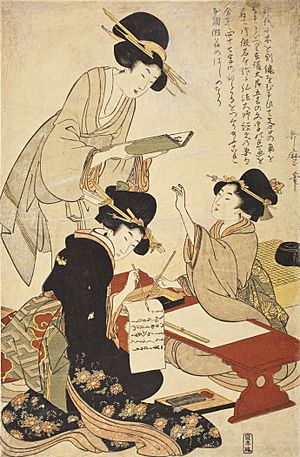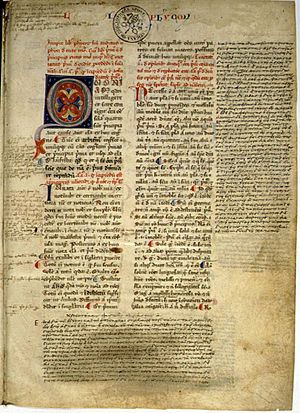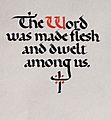Calligraphy facts for kids


Calligraphy is the art of beautiful writing. The word comes from the Greek language and means "beautiful writing." It's about making letters and words look amazing. People have used calligraphy for thousands of years to create important documents, books, and art.
In the past, before printing presses, everything was written by hand. Calligraphy was a very important skill. Scribes, who were professional writers, spent many years learning how to write perfectly.
Contents
What is Calligraphy?
Calligraphy is more than just writing neatly. It's about the shape, flow, and balance of letters. Artists use special pens, brushes, and inks to create different styles. Each stroke is carefully planned to make the writing look like a piece of art.
Tools of the Trade
To do calligraphy, you need specific tools:
- Pens: Many calligraphers use dip pens. These pens have a nib (the writing tip) that you dip into ink. There are many different nibs for different styles.
- Brushes: In East Asia, brushes are very common for calligraphy. They can make thick or thin lines depending on how you hold them.
- Ink: Special inks are used that flow smoothly and have rich colors.
- Paper: The type of paper matters too. Some papers absorb ink differently, which affects the look of the writing.
Different Styles of Calligraphy
Calligraphy has developed differently around the world. Each region has its own unique styles and traditions.
Western Calligraphy
In the Western world, calligraphy was often used for religious texts and official documents. Monks in monasteries spent years copying books by hand. They decorated the first letters of chapters with beautiful designs. This made the books look very special. While it was important, it was sometimes seen as a "minor art" compared to painting or sculpture.
East Asian Calligraphy

In East Asia, especially in countries like China, Japan, and Korea, calligraphy is considered a "high art." It's seen as important as painting or poetry. People believe that calligraphy shows the artist's personality and spirit. It has been practiced for thousands of years, even before the Tang Dynasty.
Many school children in East Asia still learn calligraphy today. It teaches them discipline, patience, and how to appreciate beauty.
Islamic Calligraphy
Islamic calligraphy is another beautiful form of this art. It often uses Arabic script and is found in mosques, books, and on pottery. Because Islam discourages images of living things, calligraphy became a very important way to decorate religious texts and buildings.
Why is Calligraphy Still Important?
Even with computers and printers, calligraphy is still a valued art form. It's used for:
- Special occasions: Like wedding invitations, certificates, and awards.
- Art: Many artists create modern calligraphy pieces.
- Learning: Practicing calligraphy can improve your handwriting and focus. It connects you to history and different cultures.
Calligraphy reminds us of the beauty of handwritten words. It shows how writing can be both a way to share information and a stunning work of art.
Images for kids
-
A painting of Susenyos I (r. 1607–1632) on a Ge'ez prayer scroll meant to dispel evil spirits, Wellcome Collection, London
See also
 In Spanish: Caligrafía para niños
In Spanish: Caligrafía para niños





